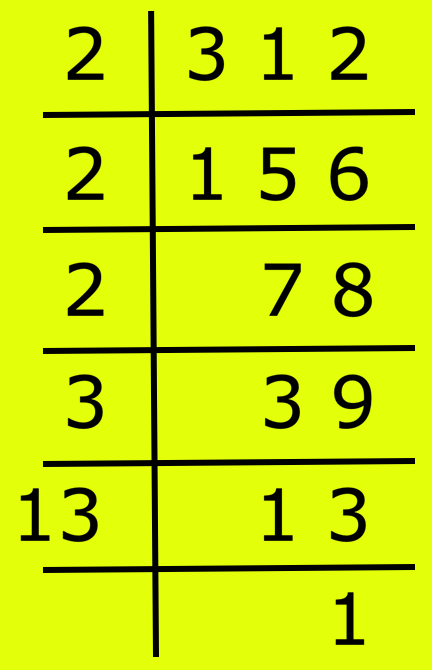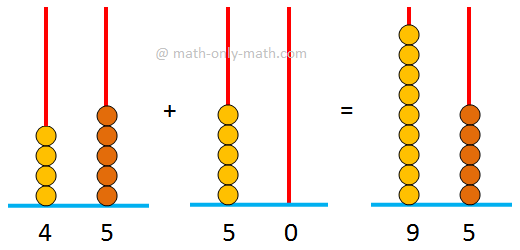Area of a Triangle Given 3 Points
Solving the problems on area of a triangle given 3 points with the help of the formula, in the below examples use the formula to find the area of a triangle given 3 points.
The area of a triangle formed by joining the points (x₁, y₁), (x₂, y₂) and (x₃, y₃) is
½ |y₁ (x₂ - x₃) + y₂ (x₃ - x₁) + y₃ (x₁ - x₂)| sq. units
Worked-out problems to find the area of a triangle given 3 points:
1. Find the value of x for which the area of the triangle with vertices at (-1, -4), (x, 1) and (x, -4) is 12¹/₂ sq. units.
Solution:
The area of the triangle with vertices at (-1, -4), (x, 1) and (x, -4) is
½ |(- 1 - 4x - 4x) - (- 4x + x + 4)|
= ½ |- 1 - 8x + 3x - 41 = 1/2 |- 5x - 5| sq. units.
By problem, ½|-1 - 5x - 5| = 12¹/₂ = 25/2
Therefore, 5x + 5 = ± 25
or, x + 1 = ± 5
Therefore, x = 4 or, - 6.
2. The point A, B, C have respective co-ordinates (3, 4), (-4, 3) and (8, -6). Find the area of ∆ ABC and the length of the perpendicular from A on BC.
Solution:
The required area of the triangle ABC.
= ½ |(9 + 24 + 32) - (- 16 + 24 - 18)| sq. unites.
= ½ |65 + 10| sq. units = 75/2 sq. units.
Again, BC = distance between the points B and C
= √[(8 + 4)² + (- 6 - 3)²] = √[44 + 81] = √225 = 15 units.
Let p be the required length of the perpendicular from A on BC then,
½ ∙ BC ∙ p = area of the triangle ABC
or, ½ ∙ 15 ∙ p = 75/2
or, p = 5
Therefore, the required length of the perpendicular from A on BC is 5 units.
3. The point A, B, C, D have respective co-ordinates (-2, -3), (6, -5) , (18, 9) and (0, 12). Find the area of quadrilateral ABC.
Solution:
We have, the area of the triangle ABC
= ½ |(10 + 54 - 54) - (- 18 - 90 - 18)| sq. units
= ½ (10 + 126) sq. units
= 68 sq. units.
Again, area of the triangle ACD
= ½ |(- 18 + 216 + 0) - (- 54 + 0 - 24)|sq. units
= ½ (198 + 78) sq. units
= 138 sq. units.
Therefore, the required area of the quadrilateral ABCD
= area of the ∆ ABC + area of the ∆ACD
= (68 + 138) sq. units
= 206 sq. units.
Alternative Method:
[This method is analogous with the short-cut method of getting the area of a triangle. Suppose, we want to find the area of the quadrilateral whose vertices have co-ordinates (x₁, y₁), (x₂, y₂), (x₃, y₃) and (x₄, y₄). For this, we write the co-ordinates of the vertices in four rows repeating the first written co-ordinates in the fifth row. Now take the sum of the products of digits shown by (↘) and from this sum subtract the sum of the products of digits shown by (↗). The required area of the quadrilateral will be equal to half of the difference obtained. Thus, the area of the quadrilateral
½ |(x₁y₂ + x₂ y₃ + x₃y₄ + x₄y₁) - (x₂y₁ + x₃y₂ + x₄y₃ + x₁y₄)| sq. units.
The above method can be used to find the area of a polygon of any number of sides when the co-ordinates of its vertices are given.]
Solution: The required area of the quadrilateral ABCD
= ½ |(10 + 54 + 216 + 0) - (- 18 - 90 + 0 - 24)| sq. units.
= ½ (280 + 132) sq. units.
= ½ × 412 sq. units.
= 206 sq. units.
4. The co-ordinates of the points A, B, C, D are (0, -1), (-1, 2), (15, 2) and (4, -5) respectively. Find the ratio in which AC divides BD.
Solution:
Let us assume that the line-segment AC divides the line -segment BD in the ratio m : n at P. Therefore, P divides the line-segment BD in the ratio m : n. Hence, the co-ordinates of P are.
[(m ∙ 4 + n ∙ (-1))/(m + n), (m ∙ (-5) + n ∙ 2)/(m + n)] + [(4m - n)/(m + n), (5m + 2n)/(m + n)].
Clearly, the points A, C and P are collinear. Therefore, the area of the triangle formed by the point A, C and P must be zero.
Therefore, ½ [( 0 + 15 ∙ (- 5m + 2n)/(m + n) - (4m - n)/(m + n) ) - (- 15 + 2 ∙ (4m - n)/(m + n) + 0)] = 0
or, 15 ∙ (-5m + 2n)/(m + n) - (4m - n)/(m + n) + 15 - 2 ∙ (4m - n)/(m + n)=0
or, - 75m + 30n – 4m + n + 15m + 15n - 8m + 2n = 0.
or, - 72m + 48n = 0
or, 72m = 48n
or, m/n = 2/3.
Therefore, the line-segment AC divides the line-segment BD internally in the ratio 2 : 3.
5. The polar co-ordinates of the vertices of a triangle are
(-a, π/6), (a, π/2) and (-2a, - 2π/3) find the area of the triangle.
Solution:
The area of the triangle formed by joining the given points
= ½ |a ∙ (-2a) sin (- 2π/3 - π/2) + (-2a) (-a) sin (π/6 + 2π/3) - (-a) ∙ a sin (π/6 + π/2)| sq. units. [ using above formula]
= ½ |2a² sin (π + π/6 ) + 2a² sin (π - π/6) -2a² sin (π/2 - π/6)|sq. units.
= ½ |-2a² sin π/6 + 2a² sin π/6 - a² cos π/6| sq. units.
= ½ ∙ a² ∙ (√3/2) sq. units = (√3/4) a² sq. units.
6. The centre of a circle is at (2, 6) and a chord of this circle of length 24 units is bisected at (- 1, 2). Find the radius of the circle.
Solution:
Let C (2, 6) be the centre of the circle and its chord AB of length 24 units is bisected at D (- 1, 2).
Therefore, CD² = (2 + 1) ₁ + (6 - 2) ²
= 9 + 16 = 25 and DB = ½ ∙ AB = ½ ∙ 24 = 12
Join CB. Now, D is the mid-point of the chord AB; hence, CD is perpendicular to AB. Therefore, from the triangle BCD we get,
BC² = CD² + BD² = 25 + 12² = 25 + 144 = 169
or, BC = 13
Therefore, the required radius of the circle = 13 units.
7. If the co-ordinates of the vertices of a ∆ ABC be (3, 0), (0, 6) and (6, 9) and if D and E divide AB and AC, respectively internally in the ratio 1 : 2, then show that the area of ∆ ABC = 9 ∙ the area of ∆ ADE.
Solution:
By question D divides AB internally in the ratio 1 : 2; hence, the co-ordinates of D are
((1 ∙ 0 + 2 ∙ 3)/(1 + 2), (1 ∙ 6 + 2 ∙ 0)/(1 + 2)) = (6/3, 6/3) = (2, 2).
Again, E divides AC internally in the ratio 1 : 2; hence, the co-ordinates of E are
((1 ∙ 6 + 2 ∙ 3)/(1 + 2), (1 ∙ 9 + 2 ∙ 0)/(1 + 2)) = (12/3, 9/3) = (4, 3).
Now, the area of the triangle ABC
= ½ |(18 + 0 + 0) - (0 + 36 + 27)| sq. units.
= ½ |18 - 63| sq. units.
= 45/2 sq. units.
And the area of the triangle ADE
= ½ |( 6 + 6 + 0) - (0 + 8 + 9)| sq. units.
= ½ |12 - 17| sq. units.
= 5/2 sq. units.
therefore, area of the ∆ ABC
= 45/2 sq. units = 9 ∙ 5/2 sq. units.
= 9 ∙ area of the ∆ ADE. Proved.
The above worked-out problems on area of a triangle given 3 points are explained step-by-step with the help of the formula.
● Co-ordinate Geometry
- What is Co-ordinate Geometry?
- Rectangular Cartesian Co-ordinates
- Polar Co-ordinates
- Relation between Cartesian and Polar Co-Ordinates
- Distance between Two given Points
- Distance between Two Points in Polar Co-ordinates
- Division of Line Segment: Internal & External
- Area of the Triangle Formed by Three co-ordinate Points
- Condition of Collinearity of Three Points
- Medians of a Triangle are Concurrent
- Apollonius' Theorem
- Quadrilateral form a Parallelogram
- Problems on Distance Between Two Points
- Area of a Triangle Given 3 Points
- Worksheet on Quadrants
- Worksheet on Rectangular – Polar Conversion
- Worksheet on Line-Segment Joining the Points
- Worksheet on Distance Between Two Points
- Worksheet on Distance Between the Polar Co-ordinates
- Worksheet on Finding Mid-Point
- Worksheet on Division of Line-Segment
- Worksheet on Centroid of a Triangle
- Worksheet on Area of Co-ordinate Triangle
- Worksheet on Collinear Triangle
- Worksheet on Area of Polygon
- Worksheet on Cartesian Triangle
11 and 12 Grade Math
From Area of a Triangle Given 3 Points to HOME PAGE
Didn't find what you were looking for? Or want to know more information about Math Only Math. Use this Google Search to find what you need.
Recent Articles
-
5th Grade Factors and Multiples | Definitions | Solved Examples | Math
Mar 23, 25 02:39 PM
Here we will discuss how factors and multiples are related to each other in math. A factor of a number is a divisor which divides the dividend exactly. A factor of a number which is a prime number is… -
Adding 2-Digit Numbers | Add Two Two-Digit Numbers without Carrying
Mar 23, 25 12:43 PM
Here we will learn adding 2-digit numbers without regrouping and start working with easy numbers to get acquainted with the addition of two numbers. -
Worksheet on 12 Times Table | Printable Multiplication Table | Video
Mar 23, 25 10:28 AM
Worksheet on 12 times table can be printed out. Homeschoolers can also use these multiplication table sheets to practice at home. -
Vertical Subtraction | Examples | Word Problems| Video |Column Method
Mar 22, 25 05:20 PM
Vertical subtraction of 1-digit number are done by arranging the numbers column wise i.e., one number under the other number. How to subtract 1-digit number vertically? -
Worksheet on 11 Times Table | Printable Multiplication Table | Video
Mar 22, 25 05:08 PM
Worksheet on 11 times table can be printed out. Homeschoolers can also use these multiplication table sheets to practice at home.






New! Comments
Have your say about what you just read! Leave me a comment in the box below. Ask a Question or Answer a Question.